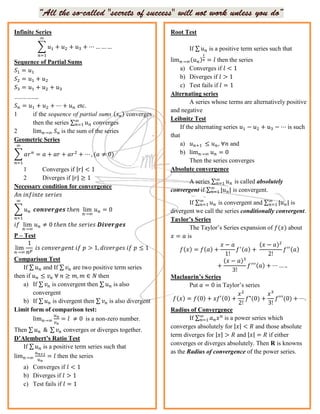Ktu - s1 me module 1 (Calculus Module 1)
- 1. Infinite Series Ōłæ Øæó1 + Øæó2 + Øæó3 + Ōŗ» ŌĆ” ŌĆ” ŌĆ” Ōł× Øæø=1 Sequence of Partial Sums Øæå1 = Øæó1 Øæå2 = Øæó1 + Øæó2 Øæå3 = Øæó1 + Øæó2 + Øæó3 ŌĆ”ŌĆ”ŌĆ”ŌĆ”ŌĆ”.. Øæå Øæø = Øæó1 + Øæó2 + Ōŗ» + Øæó Øæø etc. 1 if the sequence of partial sums (ØæĀ Øæø) converges then the series Ōłæ Øæó Øæø Ōł× Øæø=1 converges 2 lim ØæøŌåÆŌł× Øæå Øæø is the sum of the series Geometric Series Ōłæ ØæÄØæ¤ Øæø Ōł× Øæø=1 = ØæÄ + ØæÄØæ¤ + ØæÄØæ¤2 + Ōŗ» , (ØæÄ ŌēĀ 0) 1 Converges if |Øæ¤| < 1 2 Diverges if |Øæ¤| Ōēź 1 Necessary condition for convergence ØÉ┤Øæø Øæ¢ØæøØæōØæ¢ØæøØæĪØæÆ ØæĀØæÆØæ¤Øæ¢ØæÆØæĀ Ōłæ Øæó Øæø Ōł× Øæø=1 ØÆäØÆÉØÆÅØÆŚØÆåØÆōØÆłØÆåØÆö ØæĪŌäÄØæÆØæø lim ØæøŌåÆŌł× Øæó Øæø = 0 Øæ¢Øæō lim ØæøŌåÆŌł× Øæó Øæø ŌēĀ 0 ØæĪŌäÄØæÆØæø ØæĪŌäÄØæÆ ØæĀØæÆØæ¤Øæ¢ØæÆØæĀ Øæ½ØÆŖØÆŚØÆåØÆōØÆłØÆåØÆö P ŌĆō Test lim ØæøŌåÆŌł× 1 Øæø ØæØ Øæ¢ØæĀ ØæÉØæ£ØæøØæŻØæÆØæ¤ØæöØæÆØæøØæĪ Øæ¢Øæō ØæØ > 1, ØææØæ¢ØæŻØæÆØæ¤ØæöØæÆØæĀ Øæ¢Øæō ØæØ Ōēż 1 Comparison Test If Ōłæ Øæó Øæø and If Ōłæ ØæŻ Øæø are two positive term series then if Øæó Øæø Ōēż ØæŻ Øæø ŌłĆ Øæø Ōēź ØæÜ, ØæÜ Ōłł Øæü then a) If Ōłæ ØæŻ Øæø is convergent then Ōłæ Øæó Øæø is also convergent b) If Ōłæ Øæó Øæø is divergent then Ōłæ ØæŻ Øæø is also divergent Limit form of comparison test: lim ØæøŌåÆŌł× Øæó Øæø ØæŻ Øæø = ØæÖ ŌēĀ 0 is a non-zero number. Then Ōłæ Øæó Øæø & Ōłæ ØæŻ Øæø converges or diverges together. DŌĆÖAlembertŌĆÖs Ratio Test If Ōłæ Øæó Øæø is a positive term series such that lim ØæøŌåÆŌł× Øæó Øæø+1 Øæó Øæø = ØæÖ then the series a) Converges if ØæÖ < 1 b) Diverges if ØæÖ > 1 c) Test fails if ØæÖ = 1 Root Test If Ōłæ Øæó Øæø is a positive term series such that lim ØæøŌåÆŌł×(Øæó Øæø) 1 Øæø = ØæÖ then the series a) Converges if ØæÖ < 1 b) Diverges if ØæÖ > 1 c) Test fails if ØæÖ = 1 Alternating series A series whose terms are alternatively positive and negative Leibnitz Test If the alternating series Øæó1 ŌłÆ Øæó2 + Øæó3 ŌłÆ Ōŗ» is such that a) Øæó Øæø+1 Ōēż Øæó Øæø, ŌłĆØæø and b) lim ØæøŌåÆŌł× Øæó Øæø = 0 Then the series converges Absolute convergence A series Ōłæ Øæó Øæø Ōł× Øæø=1 is called absolutely convergent if Ōłæ |Øæó Øæø|Ōł× Øæø=1 is convergent. If Ōłæ Øæó Øæø Ōł× Øæø=1 is convergent and Ōłæ |Øæó Øæø|Ōł× Øæø=1 is divergent we call the series conditionally convergent. TaylorŌĆÖs Series The TaylorŌĆÖs Series expansion of Øæō(Øæź) about Øæź = ØæÄ is Øæō(Øæź) = Øæō(ØæÄ) + Øæź ŌłÆ ØæÄ 1! ØæōŌĆ▓(ØæÄ) + (Øæź ŌłÆ ØæÄ)2 2! ØæōŌĆ▓ŌĆ▓(ØæÄ) + (Øæź ŌłÆ ØæÄ)3 3! ØæōŌĆ▓ŌĆ▓ŌĆ▓(ØæÄ) + Ōŗ» ŌĆ” .. MaclaurinŌĆÖs Series Put ØæÄ = 0 in TaylorŌĆÖs series Øæō(Øæź) = Øæō(0) + ØæźØæōŌĆ▓(0) + Øæź2 2! Øæō"(0) + Øæź3 3! ØæōŌĆ▓ŌĆ▓ŌĆ▓(0) + Ōŗ». Radius of Convergence If Ōłæ ØæÄ Øæø Øæź ØæøŌł× Øæø=1 is a power series which converges absolutely for |Øæź| < Øæģ and those absolute term diverges for |Øæź| > Øæģ and |Øæź| = Øæģ if either converges or diverges absolutely. Then R is knowns as the Radius of convergence of the power series.

